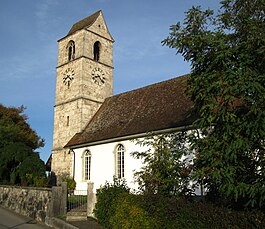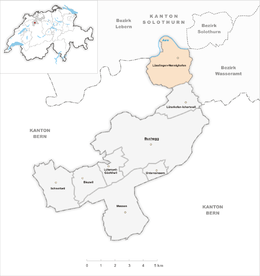Lüsslingen-Nennigkofen
| Lüsslingen-Nennigkofen | ||
|---|---|---|

Lüsslingen village church
|
||
|
||
| Coordinates: 47°11′N 7°30′E / 47.183°N 7.500°ECoordinates: 47°11′N 7°30′E / 47.183°N 7.500°E | ||
| Country | Switzerland | |
| Canton | Solothurn | |
| District | Bucheggberg | |
| Area | ||
| • Total | 7.81 km2 (3.02 sq mi) | |
| Population (Dec 2015) | ||
| • Total | 1,057 | |
| • Density | 140/km2 (350/sq mi) | |
| Postal code | 4574 | |
| SFOS number | 2464 | |
| Surrounded by | Bellach, Biberist, Leuzigen (BE), Lohn-Ammannsegg, Lüterkofen-Ichertswil, Selzach | |
| Website |
http://www.luesslingen-nennigkofen.ch SFSO statistics |
|
Lüsslingen-Nennigkofen is a municipality in the district of Bucheggberg, in the canton of Solothurn, Switzerland. On 1 January 2013, Lüsslingen and Nennigkofen merged to form Lüsslingen-Nennigkofen.
Lüsslingen is first mentioned in 1251 as in Luslingen. Nennigkofen is first mentioned in 1392 as Nennikofen or Nennikoven.
The former municipalities that make up Lüsslingen-Nennigkofen had an area of 7.81 km2 (3.02 sq mi).
Lüsslingen had an area, as of 2009[update], of 3.19 square kilometers (1.23 sq mi). Of this area, 1.76 km2 (0.68 sq mi) or 55.2% is used for agricultural purposes, while 0.85 km2 (0.33 sq mi) or 26.6% is forested. Of the rest of the land, 0.4 km2 (0.15 sq mi) or 12.5% is settled (buildings or roads), 0.2 km2 (0.077 sq mi) or 6.3% is either rivers or lakes and 0.01 km2 (2.5 acres) or 0.3% is unproductive land. The former municipality is located on the northern slope of Bucheggberg mountain. It is the closest municipality to Solothurn in the Bucheggberg district.
Nennigkofen had an area, as of 2009[update], of 4.62 square kilometers (1.78 sq mi). Of this area, 2.97 km2 (1.15 sq mi) or 64.3% is used for agricultural purposes, while 1.11 km2 (0.43 sq mi) or 24.0% is forested. Of the rest of the land, 0.36 km2 (0.14 sq mi) or 7.8% is settled (buildings or roads), 0.13 km2 (32 acres) or 2.8% is either rivers or lakes and 0.01 km2 (2.5 acres) or 0.2% is unproductive land. The former municipality is located in the Bucheggberger Aare valley.
Characterized by equable climates with few extremes of temperature and ample precipitation in all months. The Köppen Climate Classification subtype for this climate is "Cfb". (Marine West Coast Climate).
...
Wikipedia



